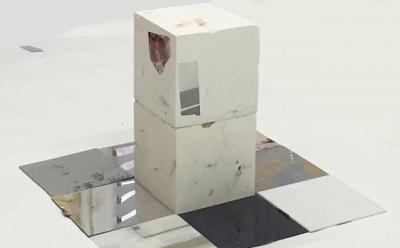Finding a Local Aesthetic in Abstraction

Although there are some outliers, it is striking how many pieces in “TERRITORY: Abstraction on the East End Today” have such a strong linear and geometric approach. Whether by accident or design, the show makes a strong case for a local aesthetic that favors such a style of abstraction.
One might not put Don Christensen’s “Stack No. 3,” Henry Brown’s “Displacement,” or Bill Komoski’s “3/1414” in such a category, but in the context of a multitude of works such as Rory MacArthur’s “Invisible Supreme” and Peter Dayton’s untitled piece from his surfboards series, their more organic, liquid, or freestyle forms begin to seem as though they spring from the same impulse.
That is not to say that everything is the same here. Instead, the curators, including Mr. Brown, Karen Flatow, and Li Trincere, have collected works from artists with unique viewpoints that still form a cohesive and relational whole. That is the surprise and the joy of the show. The East End’s summer art scene is full of far too many less worthwhile entries, particularly of a pop-up duration. This one is worth a look and more. It is taking place over the next two weekends in an Amagansett potato barn at 68A Schellinger Road. A reception will be held on Saturday from 5 to 7 p.m.
The show incorporates recent work by 24 artists, some of them full-time residents of the East End and others less so but all with work informed by visiting or living in the region. The precise linear compositions of Janet Goleas, Gabriele Evertz, and others, become the context for Charlotte Hallberg’s “So Close So Full,” a round panel painting with a target composition overlaid with solid wavy lines, or Ms. Flatow”s rippled birch woodgrain highlighted with gesso, ink, and acrylic.
Gregory Johnston’s aluminum sculpture “Kumbl (for Piet Hein)” has interior solids of rectangular shapes with rounded edges, but what stands out in this context is the strong angularity of the sheets that frame them.
This is what good curators do, find and bring together objects that help you see what is assembled and the greater art world with a new perspective. Too literal an approach looks facile and pedantic; too obscure and no one gets it.
The show is taking place in Ms. Flatow’s studio, a potato barn so nestled into the ground that on a hot Sunday it could have been called “Cold Storage.” Ms. Flatow and Ms. Trincere said it was a case of friends and friends of friends getting together. The shared aesthetics grew organically.
Pieces in the exhibition seem to coalesce around just a few sensibilities. There are the hard-edged geometric works, the more amorphous pieces, and those in between.
Eric Brown’s “I Wonder You” could be interpreted as floral or, more literally, as an egg in a frying pan, but really eludes exact definition. Amanda Church’s blobs, outlined in red, could be alien fingers or dancing amoebae, but in any case are joyful and fun. Mr. Komoski flirts with Op Art, but his central figure might be construed as a more abstract Chuck Close “Head.” The Op Art association is strengthened by Taro Suzuki’s spiral abstraction.
The pieces from Lauren Luloff, Lola Montes, and Christine Scuilli coalesce around a looser and more painterly approach, even though Ms. Sciulli uses light to create her compositions and Ms. Luboff uses fabric.
Drew Shiflett skirts these camps, using a linear design that is subtle and suggestive in ink, graphite, and watercolor on handmade paper. Its all-over format seems almost gestural in its sketchiness. Chuck Manion’s painting has a softer free-form feeling, even though it is still strongly graphic.
The three sculptural pieces all attract attention for different reasons. The blockiness of Ryan Wallace’s “Crostics” is underscored by Ms. Trincere’s untitled acrylic painting, which plays with perception in a different way. Almond Zigmund’s “Block Print I” has an Inuit or Pueblo totemistic quality. It pairs nicely with Tad Wiley’s “The Waternix” and Chris Haub’s acrylic and vinyl on linen piece.
Off on its own in the entry foyer, Mr. Gonzalez’s “Unauthorized Donald Judd Chair in a Wind Tunnel” plays well with itself. The alluded-to chair, painted in a way that mimics the pooling of light around it, is accompanied by a virtual-reality wall projection recording of air waves surrounding the chair in a wind tunnel. The piece includes a fan, as if to suggest that we are witnessing a live feed of the air flowing over it, but it is merely artifice, a delightful wink at the pseudo-science themes of Minimalism.
The show will be on view this weekend and next weekend only, Saturday and Sunday, noon to 6 p.m., or by appointment.
